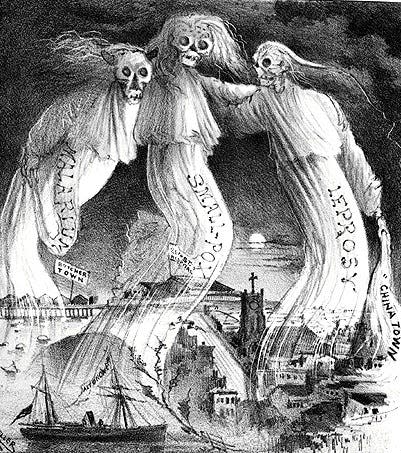Asian American history is already whitewashed, and it's about to get even worse

Tom Horne is adamant our K-12 public schools are indoctrinating our students with critical race theory, taught outright or "under many guises."
As a mom of 3 school aged boys, I am observing the opposite: a trepidation in classrooms to explore the full truth for fear of facing our state superintendent's wrath.
My fifth grader is learning about U.S. immigration in the mid-19th century. History at his public school is taught twice a week, which means much is left unexplored.
I was heartened to see he was assigned a project to research the Chinese Exclusion Act of 1882, but many of his other classroom texts and handouts are sanitized and limited in scope.
With lawmakers all across America successfully codifying anti-CRT (critical race theory) legislation, book banning and hysteria that, in Arizona, led the school superintendent to set up an “Empower Hotline” to report “inappropriate” K-12 curriculum, I fear lessons will become even more distorted, and stray further from the truth.
Soon, our children will consume history without context.
Asian immigration is rarely taught now
One of the texts used as a learning tool is a Reader’s Theater passage on Immigration. Reader’s Theater is performance theater that engages students in a topic while also promoting literacy and public speaking skills.
Yet, taught without context, the actual history of the lesson is lost to the art of the performance.
As someone who advocates for a more diversified curriculum in K-12 classrooms, I am always encouraging educators to expand the historical narrative to include previously marginalized communities.
This is all the more important here in Arizona, where 64% of our public school students are minorities.
These untold truths paint a fuller picture of U.S. history and help students personally relate to events of the past.
Rarely is Asian immigration part of this discourse, despite the fact that the mid-19th century period marked the first wave of Asian immigration to the United States, much of it from Chinese laborers to work in the California gold mines and on the Transcontinental Railroad.
My great grandfather was part of this wave of Chinese migration to western Canada.
Fear of covering ugly facts leaves a lot out
This is my family’s lived experience, yet it is barely a footnote in any elementary lesson about immigration, including this Reader’s Theater.
While we focus on passing critical race theory legislation to ensure white children do not feel bad for historical injustices they did not inflict, what are the consequences of my Chinese boys and their ancestors being erased from our country’s history?
A history that covers uglier facets of our social and legislative structures of the time, including racist tropes of Chinese immigrants “carrying disease” and “stealing jobs.”
And the Chinese Exclusion Act of 1882 – the first significant legislation restricting immigration that made scapegoats of Chinese workers for depressed wages and labor unrest.
I worry these truths won’t be fully acknowledged or taught for fear that uncomfortable truths will be conflated as “controversial material.”
My son's lessons are tone deaf today
Our immigration of yesterday and today is fraught with discrimination, and to gloss over the time period and the subject matter with half-truths distorts the harsh realities many faced and continue to face in their struggle to gain acceptance into our country.
The play implies our system is fair, orderly and merit based. It is no wonder students cannot draw any parallels from this version of immigration to our current events at the Southern border.
Every 10th line in the play is a chorus of voices reciting a part of the sonnet inscribed on the pedestal of the Statue of Liberty, “Give me your tired, your poor, Your huddled masses yearning to breathe free.”
Book bans to bathrooms: Lawmakers push new rules for classrooms
Beautiful words that encapsulate the spirit of American immigration, especially of the time – but, frankly, tone deaf today given that we currently have huddled masses of tired and poor Central Americans in downtown El Paso living in limbo.
What makes these immigrants less deserved than the ones from yesterday?
Anti-CRT assault makes it tough to teach
These are honest discussions that can help students build critical thinking, examine history and maybe even inspire students to enact change.
A dangerous result of neatly packaging history is the complete misuse of terminology: “Some immigrants were brought to America against their will as slaves,” the play notes.
Slavery is a shameful chapter of our American history.
Slavery is not a type of immigration, and suggesting so perpetuates euphemistic terms that do not adequately describe the inhumanity of the Black American experience.
Moreover, we’re feeding a dangerous narrative to children where they’re not learning about the structural barriers set in place to disadvantage certain populations.
Without that truth, children lack the ability to develop empathy for others, as they are taught that we all originate from the same “melting pot” with all the same baseline benefits and privileges.
It is such a precarious time to be a public K-12 educator in Arizona and the risks continue to pile on faster than the benefits.
If legislators and the state superintendent continue down this path of muzzling teachers, we may not hold any truths to be self-evident.
Yvonne So is a mom, AAPI activist and host of iHeart Radio and Seneca Women podcast, “Cashing our Trillions,” which spotlights the work moms do to sustain the $1.5 trillion economy of unpaid female work. Reach her at cashingourtrillions@gmail.com.
This article originally appeared on Arizona Republic: Asian American history is already whitewashed. It's going to get worse
